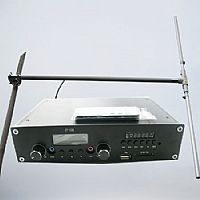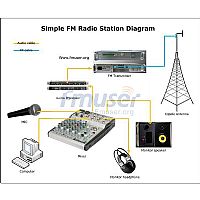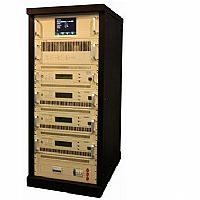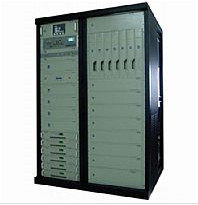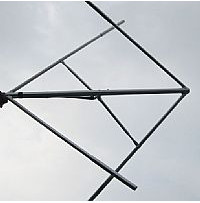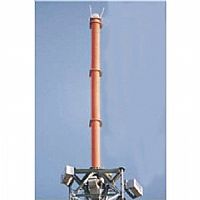I. Introduction
Smart antennas are usually called adaptive antenna arrays, which can form specific antenna beams to achieve directional transmission and reception, and are mainly used to complete spatial filtering and positioning. Essentially, it uses the positional relationship between the elements in the antenna array, that is, the phase relationship of the signal to overcome multiple access interference and multipath interference. This is the essential difference between it and traditional diversity technology.
The MIMO system refers to a communication system that simultaneously uses multiple antennas at the transmitting end and the receiving end. It effectively uses random fading and possible multipath propagation to double the service transmission rate. Its core technology is space-time signal processing, which uses a combination of multiple time domains and spatial domains distributed in space for signal processing. Therefore, it can be seen as an extension of smart antennas.
The smart antenna system has multiple antennas at the transmitting end/or receiving end of the mobile communication link. According to whether the signal processing is located at the transmitting end or the receiving end of the communication link, the smart antenna technology is defined as multiple input single output (MISO). Single Output, Single Input Multiple Output (SIMO, Single Input Multiple Output) and Multiple Input Multiple Output (MIMO, Multiple Input Multiple Output), etc.
2. Multi-input and multi-output smart antenna transceiver structure and research progress
It can be seen from Figure 1 that after encoding, modulation, and space-time processing (beam formation or space-time coding), the bit stream is mapped into different information symbols and transmitted from multiple antennas at the same time; multiple antennas are used at the receiving end Receive, perform corresponding demodulation, decoding and space-time processing.

Figure 1 Multiple-input multiple-output smart antenna transceiver structure
The space-time processing technologies in the MIMO system mainly include beamforming, space-time coding, and space multiplexing. Beamforming is a key technology in smart antennas, which improves the signal-to-noise ratio by directing the main energy to the desired user. Beamforming can effectively suppress co-channel interference, and the key is to determine the beamforming weight.
1. Transmission scheme of MIMO system
The transmission scheme of the MIMO system is mainly divided into two types: the transmission scheme that maximizes the data rate (spatial multiplexing SDM) and the transmission scheme that maximizes the diversity gain (space-time coding STC). The maximum data rate transmission scheme mainly realizes spatial multiplexing by transmitting independent signals on different antennas. The space-time coding scheme refers to the joint coding of the data stream at the transmitting end to reduce the symbol error rate caused by channel fading and noise. It increases the redundancy of the signal through joint coding at the transmitting end, so that the signal is received The end gains diversity gain, but the space-time coding scheme cannot increase the data rate.
(1) Space-time coding A large number of transmission mechanisms are given in some documents. These mechanisms can respectively maximize the spectrum efficiency, the highest rate, and the signal to noise ratio (SNR, Signal to Noise Ratio). They all rely on channel state information (CSI). , Channel State Information) is known to the transmitter and receiver. The CSI can be obtained at the receiving end through channel estimation, and then the transmitting end can be notified through feedback.
For transmission mechanisms that do not require CSI at the transmitting end, space-time coding can be introduced or spatial multiplexing gain can be used to take advantage of the space dimension. Space-time coding is mainly divided into space-time trellis codes and space-time block codes. The received signal is detected by the maximum likelihood (ML, Maximum Likelihood) decoder. The earliest space-time code is STTC (Space-Time Trellis Code). In this way, the receiver needs a multi-dimensional Viterbi algorithm. The diversity that STTC can provide is equal to the number of transmit antennas, and the coding gain provided depends on the complexity of the codeword without sacrificing bandwidth efficiency. Space-Time Block Code (STBC, Space-Time Block Code) can provide the same diversity gain as STTC, but it has no coding gain. Also, since STBC only needs linear processing when decoding, STBC is usually used. Space-time coding technology generally assumes that CSI is completely known at the receiving end. When CSI is unknown at both ends, unitary space-time coding and differential space-time coding are proposed.
(2) Spatial multiplexing Spatial multiplexing refers to transmitting independent signals at the transmitting end, and using ZF, MMSE, ML, V-BLAST [3] and other methods for decoding at the receiving end. It can maximize the average transmission rate of the MIMO system and can sacrifice some data rates to obtain higher diversity gain.
(3) Combination of space multiplexing and space-time coding Combine space multiplexing and space-time coding, and maximize the average data rate under the condition that each data stream obtains the minimum diversity gain. At present, there are mainly two schemes that combine spatial multiplexing and space-time coding, link coding and adaptive MIMO systems using block code mapping. Linked coding scheme refers to the internal use of space-time coding, external use of traditional channel error correction code (TCM, convolutional code, RS code) coding scheme [4], this scheme can not only provide diversity gain, but also improve the system capacity. Because the correlation between channels will affect the spectrum efficiency of the multi-antenna system, when the channel is in an ideal state or the correlation between channels is small, the transmitter adopts a spatial multiplexing transmission scheme, and when the correlation between channels is large, space-time coding is used. Launch plan.
2. MIMO receive diversity technology
The decoding algorithms of the MIMO system at the receiving end mainly include ZF algorithm, MMSE algorithm, decision feedback decoding algorithm, maximum likelihood decoding algorithm and layered space-time processing algorithm (bell labs layered space-time, BLAST). Among them, the zero-forcing algorithm and the MMSE algorithm are linear algorithms, while the decision decoding algorithm, the maximum likelihood decoding algorithm and the layered space-time processing algorithm are non-linear algorithms. At the receiving end of the SIMO or MIMO communication link, the receiver or equalizer uses the multipath signal to reconstruct the transmitted signal. In the non-frequency-selective SIMO channel, the optimal receiving mechanism is Maximum Ratio Combining (MRC, Maximum Ratio Combining); for the frequency-selective SIMO channel, the optimal receiving mechanism is ML detection, but it is nonlinear, and its complexity is similar to that of the antenna. The number is exponential (can be replaced by a linear decoder, but the performance will be reduced). The ZF equalizer can eliminate the inter-symbol interference ISI (InterSymbol Interference) through the inverse of the channel, but at the cost of amplifying the noise. The MMSE receiver can make a trade-off between noise amplification and ISI cancellation. Decision Feedback Equalizer (DFE, Decision Feedback Equalizer), a suboptimal nonlinear mechanism based on decision feedback, can be used to improve the performance of a linear equalizer. It eliminates part of the ISI generated by the previous symbol from the current symbol through a feedback filter. ML and linear equalization can be extended to MIMO channels. The problem related to MIMO receivers is the existence of multi-stream interference (MSI, Multistream). MSI can cause mutual interference between multiple data streams. Non-linear continuous cancellation equalizer or V-BLAST equalizer can convert MIMO channels into parallel channels, but this mechanism may have error propagation.
3. Beamforming technology in MIMO system
(1) The system model of the eigenbeamforming MIMO system is r=Hs+n, and the channel matrix H is subjected to singular value decomposition. If the channel information is known at the transmitting end, the eigenbeamforming at the transmitting end and linear processing at the receiving end can be used to transform the MIMO The channel is divided into parallel sub-channels. If the transmitter does not know the channel state information, in a multi-user environment, a random beamforming method can be used to achieve multi-user diversity.
(2) Combination of beamforming and space-time coding In most cases, it is reasonable to assume that part of the CSI information is known at the transmitting end, so a hybrid mechanism combining space-time coding and beamforming is proposed. Space-time coding and beamforming are two different transmit diversity technologies. Space-time coding belongs to an open-loop diversity technology and does not require channel information at the transmitting end; array beamforming is a closed-loop diversity technology that uses channel feedback information for spatial filtering or interference suppression. The accuracy of channel feedback will seriously affect the effect of beamforming. When the sender obtains part of the channel state information (such as channel average or channel covariance matrix), the transmission strategy (beamforming or space-time coding [5]) can be selected according to the channel information. The weight of beamforming is determined by the feedback channel information under the condition of ensuring that the receiving end meets the requirements of signal-to-noise ratio and bit error rate. Documents [6][7] point out that combining power allocation, beamforming and space-time coding has an effect on the transmitter Joint optimization provides better performance than traditional space-time coding without increasing equipment complexity and loss of transmission rate.
In short, the performance metrics that describe the characteristics of the MIMO smart antenna transceiver are Mean Square Error (MSE), SNR, Bit Error Rate (BER, Bit Error Rate), reachable throughput, required transmit power, and Channel capacity. The transmission and reception mechanisms are optimized according to these criteria. The design of its transceiver should pay special attention to the following four key parameters: (1) the reliability of the CSI at the transmitter and receiver; (2) the characteristics of the transmitted signal (modulation, multiplexing and training information); (3) optimization Performance measurement; (4) Computational complexity.
2019-6-11 09:07:33 Comment Report
e085086068
0 Three, the advantages of smart antennas
In mobile communication systems, multipath and multipath delay extension are the main problems in mobile communication. Multipath propagation will cause severe signal fading, and delay spread will cause inter-symbol interference, which will seriously affect the quality of communication links. At the same time, co-channel interference is the main limiting factor for the capacity of mobile communication systems, which will affect the reuse of effective network resources (frequency, time) by users. Smart antennas can improve link quality by using multipath, increase system capacity by reducing mutual interference, and allow different antennas to transmit different data. In short, the advantages of smart antennas can be summarized as follows:
(1) Increasing coverage. Coherent reception of signals by the antenna array at the receiving end can generate array or beamforming gain, which is proportional to the number of receiving antennas.
(2) Power reduction/cost reduction Smart antennas optimize the transmission of specific users, which can reduce the transmission power, thereby reducing the cost of the amplifier.
(3) The forms of improving link quality/increasing reliability include time diversity, frequency diversity, code diversity, and space diversity. When using smart antennas to sample the spatial domain, spatial diversity occurs. In a non-frequency selective fading MIMO channel, the maximum spatial diversity order is equal to the product of the number of transmitting antennas and the number of receiving antennas. Multiple transmit antennas can generate transmit diversity by using a special modulation and coding mechanism, and the receive diversity of multiple receive antennas depends on the combination of independent fading signals.
(4) Increase spectrum efficiency. Accurately controlling the transmit power through different methods will reduce co-channel interference, thereby increasing the number of users using the same resources. Realization of space division multiple access (SDMA) through beamforming can achieve resource multiplexing, thereby increasing data rate and spectrum efficiency. This gain is also called spatial multiplexing gain. In the MIMO system, multiple independent spatial dimensions are used to simultaneously transmit data. In an uncorrelated Rayleigh fading MIMO channel, the channel capacity is proportional to the minimum number of transmit and receive antennas.
Smart antennas are usually designed to focus on one of the above-mentioned gains, such as beamforming, diversity gain, and multiplexing gain. The trade-off between these gains has recently become the focus of research.
4. Smart antenna technology in future mobile communication systems
Future mobile communication systems require signal processing technologies that can be adapted to various communication environments. Therefore, the initial stage of future smart antenna design must carefully consider the compromise between performance and complexity.
1. Reconfigurability of the physical layer
In order for the mobile communication transceiver to work in an environment where multiple parameters are continuously changed, it is necessary to adopt a reconfigurable adaptive technology in the transceiver to adjust the structure to obtain the best performance. The reconfigurability in the smart antenna transceiver can be regarded as the intelligent switching of the transceiver structure in various environments. For example, literature [8][9] proposed an algorithm for the compromise between space diversity and multiplexing in MIMO channels.
2. Optimization between different layers
The interaction between the high-levels defined by the OSI (Open System Interconnection) model can improve the performance of the entire system. The smart antenna is designed by combining the parameters of the physical layer, the link layer, and the network layer, that is, the design takes into account the relationship between the various layers, rather than considering a single layer. Practice shows that it is inefficient to consider the performance evaluation of the design method of one layer alone. For example, when scheduling is introduced, the gain obtained through space-time coding will decrease or even disappear.
The information exchanged between different layers of OSI can be classified as follows: (1) CSI: It is necessary to estimate the channel impulse response, positioning information, vehicle speed, signal strength, interference strength, interference model, etc. (2) QoS related parameters: including time delay, throughput, bit error rate, packet error rate (PER, Packet Error Rate), etc. (3) Physical layer resources: including space processing mechanism, number of antenna arrays, loss of battery power, etc.
It is very important to consider optimization criteria between layers. In the actual system, the link quality of the smart antenna not only depends on the data detection method adopted, but also depends on the specific coding mechanism and the medium access control (MAC, Medium Access Control) function adopted at the link layer. The protocol stack performance used in the upper layer. Therefore, the above factors should be considered comprehensively when designing, rather than a single factor. For delay-insensitive services, the smart antenna technology such as V-BLAST is combined with the Hybrid Automatic Repeat Request (H-ARQ, Hybrid Automatic Repeat Request) mechanism.
3. Multi-user diversity
In multi-user communication, a communication method called opportunity mechanism has been paid attention to. The basic idea is to multiplex by assigning channels to users who are most likely to complete continuous transmission. This can maximize the throughput of the system. For reflective spatial channels, the opportunistic beamforming method will point to the users with the highest SNR; on the other hand, in the case of sufficient scattering, the chance mechanism will allocate the channel to those users with the highest instantaneous capacity. The opportunity mechanism can generate multi-user diversity, which can be a supplement to code diversity, time diversity, frequency diversity, or space diversity. But affecting the design of the MAC protocol, MAC will abandon the conflict detection mechanism and turn to the multi-user mechanism.
4. Actual performance evaluation
In the future mobile communication system, the use of smart antennas mainly depends on the results of two studies:
(1) In the design stage of the future system, the characteristics of smart antennas and mobile communication environment, such as propagation characteristics, antenna array configuration, service mode, interference situation, and signal bandwidth effectiveness, should be considered to ensure compatibility;
(2) According to the key parameters related to the future system, the actual performance of the smart antenna is evaluated through the optimization compromise between link-level simulation and system-level simulation.
V. Summary
The use of multi-antenna technology in 3G based on CDMA technology can effectively reduce multiple access interference, and space-time processing can greatly increase the capacity of the CDMA system. With their outstanding performance in improving spectrum utilization, MIMO and smart antennas have become hot topics in the development of 4G. This article uses the combination of smart antennas and MIMO systems to give a multi-input multi-output smart antenna transceiver space-time signal processing scheme, discusses the advantages of smart antennas and future development trends of smart antennas, and also explains the problems encountered in the design . In short, the rational use of smart antenna technology will greatly improve the performance of future mobile communication systems.
Our other product:


